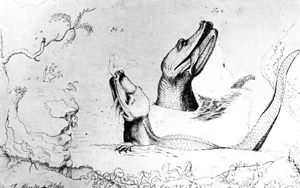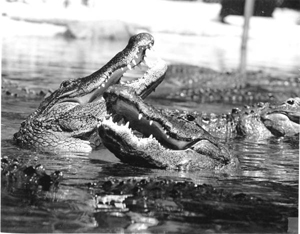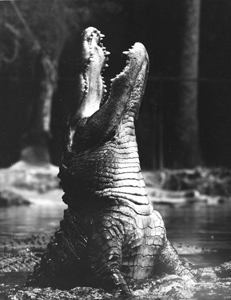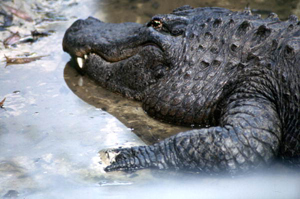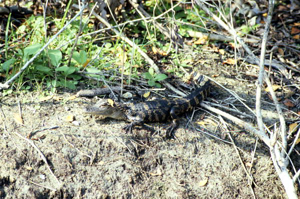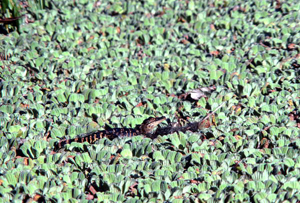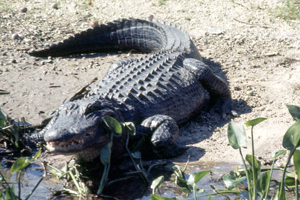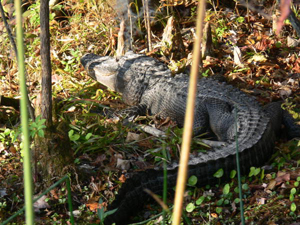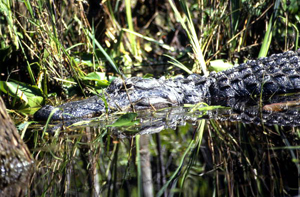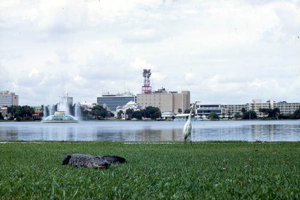Photo Exhibits
Photo exhibits spotlight various topics in Florida history, and are accompanied by brief text intended to place selected materials in historical context.
Alligators in the Backyard
Perhaps nothing symbolizes Florida in the popular imagination more than the American Alligator (Alligator mississippiensis). From the earliest Native American and European explorers to the present day, visitors have maintained a fascination with the cold-blooded, freshwater reptile. With a name derived from the Spanish word legarto (the lizard), alligators can grow to an average of 13 to 15 feet and weigh between 500 and 1,000 pounds. Once hunted and harvested to near extinction (from 1967 to 1987, it was a listed as an endangered species), the alligator has thrived in recent years, although its natural habitat has not. Nonetheless, "gators" can be found throughout Florida's popular culture, from tourist attractions and alligator wrestlers to postcards and team mascots.
Drawing by naturalist William Bartram of alligators in the St. Johns River (1770s)
Image Number: PR00131
Alligators are found in the wetlands of the U.S. Southeast. Although Native Americans and Spanish settlers witnessed and hunted alligators for years, Pennsylvania-based naturalist Bartram was one of the first scientists to document the reptile during his four-year expedition in southern English colonies in the 1770s.
Alligators swimming in Florida waters (19--)
Image Number: RC07971
Alligators are predators who will eat anything from small birds, fish, and turtles to small mammals, deer, and wild pigs. Attacks on humans are rare and usually not fatal (although they can be)
Male alligator bellowing during mating season: Homosassa Springs, Florida (1950s)
Image Number: PR00136
Male alligators bellow during the spring to attract females as well as to warn away other male competitors.
Alligator resting on bank: Homosassa Springs, Florida (19--)
Image Number: DL0914
The largest alligator officially recorded in Florida was 17 feet, 5 inches, while the largest ever was 19 feet, three inches, reported in Louisiana.
Newly hatched alligator: Broward County, Florida (1986)
Image Number: DL0917
The mother alligator builds a nest of sticks and mud near the water into which she lays twenty to fifty eggs. These eggs are kept warm by the decomposition of the vegetation. The temperature of the eggs determines the sex of the hatchlings, which hatch after approximately 65 days.
Immature gator in water lettuce at Corkscrew Swamp: Collier County (1978)
Image Number: DL0838
Although they are feared predators as adults, young alligators are vulnerable to predation by birds, large fish, and small mammals. Therefore they spend their first year under the watchful care of their mothers. Many of the attacks by alligators upon humans are out of protection of alligator's nests and/or their young.
Adult alligator in the Florida Everglades: Broward County, Florida (1971)
Image Number: DL0912
Alligators reach maturity between eight to thirteen years, usually at around six to eight feet in length. While they will continue to grow for the remainder of their lives, their growth rate slows considerably.
Alligator at the Edward Ball Wakulla Springs State Park (2007)
Image Number: PR30369
On average, alligators live in the wild to thirty or more years. In captivity, they live considerably longer, to well-over fifty years in some cases.
Alligator hunts for prey: Broward County, Florida (1986)
Image Number: DL0904
Alligators disguise themselves as floating logs while waiting for prey. Although they can sit still for hours (which also allows them to conserve their body heat), alligators can move astonishingly fast once a desired meal comes into range.
Urban gator: Lakeland, Florida (1969)
Image Number: DL0841
As development increases throughout the state and natural habits decrease, humans and alligators have increasingly found themselves sharing real estate.

 Listen: The Gospel Program
Listen: The Gospel Program